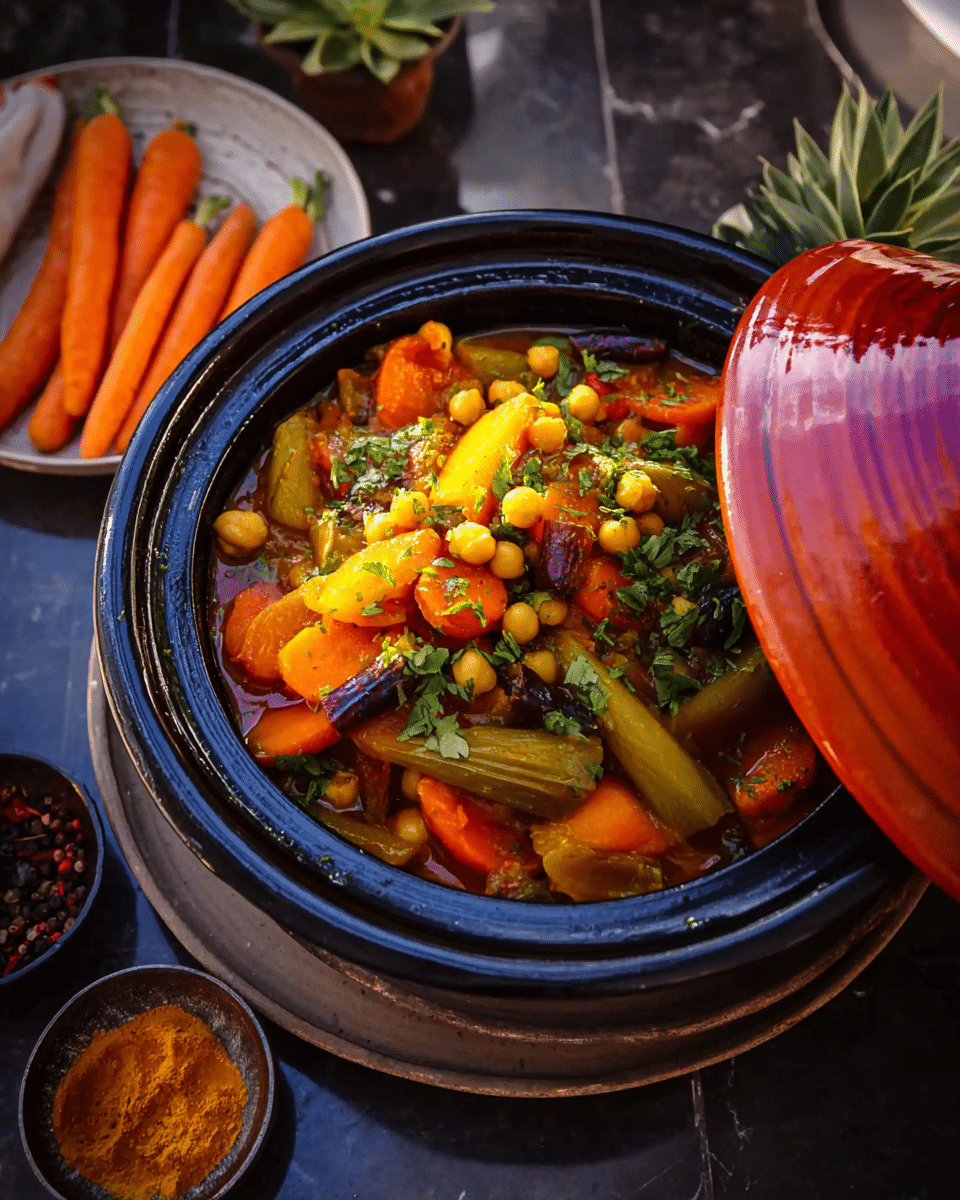This hearty stew combines the warmth of spices with the earthiness of chickpeas, creating a dish that feels like a warm hug on a chilly night. Slow-cooked to perfection, it infuses every ingredient with the rich flavors of the Moroccan spice blend. What sets this stew apart is its unique blend of spices that create a fragrant aroma, making your kitchen feel like a Moroccan bazaar. It’s not just delicious; it’s also healthy and packed with protein, making it a popular choice for both vegans and meat-lovers alike!
Full Recipe:
Ingredients
-
1 can of chickpeas, drained
-
1 onion, chopped
-
2 garlic cloves, minced
-
1 carrot, diced
-
1 bell pepper, diced
-
1 can of diced tomatoes
-
2 cups vegetable broth
-
1 tsp cumin
-
1 tsp coriander
-
1 tsp cinnamon
-
Salt and pepper to taste
-
Cilantro for garnish
Directions
-
In a large pot over medium heat, sauté the chopped onion and minced garlic until softened.
-
Add the diced carrot and bell pepper. Cook for about 5 minutes until slightly tender.
-
Stir in cumin, coriander, and cinnamon. Cook for 1-2 minutes until fragrant.
-
Add chickpeas, diced tomatoes, and vegetable broth. Stir to combine.
-
Bring the mixture to a boil, then reduce heat to low. Simmer uncovered for 25-30 minutes, stirring occasionally.
-
Season with salt and pepper to taste.
-
Serve hot, garnished with fresh cilantro.
Nutrients
(Approximate per serving – based on 4 servings)
-
Calories: 210
-
Protein: 8g
-
Carbohydrates: 32g
-
Fat: 5g
-
Fiber: 8g
-
Sugar: 7g
-
Sodium: 460mg
The Cultural Backdrop
Moroccan cuisine is renowned for its bold use of spices, and this chickpea stew captures that spirit. The choice of cumin, coriander, and cinnamon is no accident; these are staples in North African kitchens. Cumin adds a nutty warmth, coriander brings a citrusy brightness, and cinnamon offers a hint of sweet complexity. Combined, they create a signature Moroccan profile that is aromatic and layered without being overwhelming.
This stew’s appeal lies in how these elements are carefully balanced. It reflects a culture that values patience and slow cooking—a contrast to the fast-paced demands of modern life. By embracing a slower cooking method, the flavors are given time to evolve, meld, and mature, creating a deeply satisfying result.
Chickpeas: The Humble Powerhouse
Chickpeas, also known as garbanzo beans, are the foundation of this dish. These legumes have been cultivated for thousands of years and are a dietary staple in the Mediterranean and Middle Eastern regions. What makes chickpeas remarkable is their nutritional value. High in protein and fiber, they provide long-lasting energy, making this stew a wholesome option for those looking to eat healthfully without compromising flavor.
Beyond nutrition, chickpeas absorb the surrounding flavors remarkably well. In this recipe, they act like sponges for the Moroccan spice blend and vegetable broth, becoming rich and flavorful after simmering. Their firm texture also contrasts beautifully with the softness of cooked vegetables and the gentle bite of diced tomatoes.
Health Benefits Beyond the Bowl
One of the most appealing aspects of this stew is its health-conscious profile. It’s naturally vegan, yet protein-rich—perfect for anyone wanting to reduce their meat intake without sacrificing satisfaction. With only around 210 calories per serving, it’s ideal for those monitoring caloric intake while still seeking a nourishing meal.
The vegetables add more than just flavor and color. Onions and garlic provide anti-inflammatory properties and immune-boosting benefits. Carrots are rich in beta-carotene, vital for eye health, while bell peppers offer a generous dose of vitamin C. Tomatoes, being high in lycopene, contribute to heart health and may reduce cancer risk.
Then there’s fiber. With 8 grams per serving, this stew supports digestion, helps manage blood sugar, and promotes a feeling of fullness. All this makes it a smart choice not just for taste, but also for long-term well-being.
A Meal for All Seasons
Though it is especially comforting in colder months, this stew can easily be enjoyed year-round. In winter, it’s the culinary equivalent of a warm blanket. In spring or summer, it can be served slightly chilled or at room temperature for a refreshing twist. Pair it with couscous, flatbread, or even a simple green salad to transform it into a more substantial meal.
Its versatility extends to how it’s served. Whether ladled generously into deep bowls for a family dinner or presented as part of a mezze spread for guests, the stew adapts effortlessly to different occasions. Add a dollop of yogurt or a squeeze of lemon juice for a new flavor dimension, or increase the spice level with a touch of chili for those who crave heat.
Global Flavors, Local Ingredients
What’s remarkable about this dish is how globally inspired flavors can be achieved using readily available ingredients. Almost everything in the recipe can be found in a standard pantry or grocery store. The familiarity of the vegetables combined with the exotic allure of Moroccan spices makes this an accessible gateway for those new to international cooking.
This fusion of familiar and foreign not only makes the stew more approachable but also expands culinary horizons. For many home cooks, it’s an introduction to a broader world of flavor without requiring specialty shopping or advanced techniques.
Sustainability and Simplicity
This stew also aligns well with sustainable cooking practices. It’s plant-based, which has a lower environmental impact than meat-based meals. It’s also budget-friendly—canned chickpeas, common vegetables, and dried spices are cost-effective yet nutrient-dense. Making a large batch means leftovers for several days, which helps reduce food waste and save time.
Additionally, the one-pot nature of the recipe simplifies clean-up and preparation. Whether you’re a seasoned home chef or just learning to cook, the ease of this recipe encourages more cooking from scratch, a habit that is both healthier and more sustainable in the long run.
From Kitchen to Table: The Experience
Part of what makes this stew so memorable is the sensory experience it creates. The smell of onions sautéing with garlic is inviting on its own, but once the spices hit the pot, the kitchen transforms. The scent is unmistakably rich and layered, teasing the taste buds long before the first bite. As the stew simmers, it builds anticipation, drawing people to the kitchen, ready to gather and enjoy.
Once served, the stew delivers a comforting consistency—soft chickpeas, tender vegetables, and a gently thickened broth that coats the spoon. The fresh cilantro garnish not only adds a pop of color but also a fresh, herbal note that lifts the whole dish.
Conclusion: A Stew That Nourishes Body and Soul
In a world where meals are often rushed or reduced to convenience, this Moroccan chickpea stew is a reminder of the joys of intentional, flavorful, and nourishing cooking. It brings people together, feeds the body with wholesome ingredients, and satisfies the soul with comforting warmth.
Whether you’re introducing more plant-based meals into your routine, exploring international flavors, or simply looking for a hearty, delicious dish to share with loved ones, this stew delivers. With its blend of ease, nutrition, and flavor, it has all the makings of a modern classic—and one that earns a permanent place in your kitchen repertoire.






